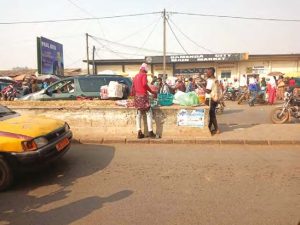The fight continues
CHILD LABOUR
Children have a unique and privileged place in the society since they are a vulnerable group of human beings. But often, their due rights are trampled upon either knowingly or unknowingly. Child labour is happening right under our noses.

Out of say 10 hawkers, at least 03 are under-aged children. At Post Centrale – Yaounde for instance, sometimes under scotching conditions, you find minors carrying loads of items varying from dresses, fruits, electronics, fast foods to other merchandise. In order to find potential buyers, they are obliged to crisscross roads as well as gallivant the nooks and crannies of towns and cities. Talking to Justitia, a Bamenda-based eyewitness said, “It is common to find teenage hawkers in major streets. These youngsters are exposed to dangers of poor health…risk being crushed by vehicles… Generally the life of a Bamenda child can be described as that of suffering…” This means that victims are usually exposed to dangers like accidents, rape and insecurity to name but these. In July 2018, in one of her publications, Cameroon Report News Media noted with dismay the fact that, despite Government efforts to crackdown the phenomenon of child labour, some Kribi parents were still headstrong. The news organ reported how it was commonplace to meet children of less than 10 years hawking on the streets of the seaside resort town. Bothered by the incessant act, a unit of the Kribi police picked up 21 minors aged between 6 and 13. It was a calculated attempt to fish-out their parents to let them know the crime they were committing. Yaounde and Kribi are just two of the many places where child labour is critically gaining ground. More instances are unaccounted for in other Cameroonian societies. It goes without saying that child labour victims suffer deprivation from their childhood, potentials, dignity, which is undeniably harmful to their physical and mental development.
The Law Against Child Labour
It has been proven that 168 million children are victims of child labour across the globe, with over 75 million of them believed to work in hazardous conditions. The 2012-2016 International Labour Organisation estimates of child labour trends also reveal that, Sub-Saharan Africa, which harbours Cameroon, is the region with the highest percentage of child labour, 19.6%. It is widely believed that the phenomenon is predominant in Cameroon, probably because it is a transit point bordered by conflict-stricken countries in Central and West Africa. That said, the obvious questions are: Is there a legal framework fashioned to curb the ill in the country? Apart from the question of law, what is the Government doing to expunge the practice? Cameroon’s Labour Code (CLC) not only recognises but aptly addresses concerns of child labour. Chapter III of Law No. 92/007 of 14 August 1992 zooms on the employment of young persons in Cameroon. Section 86 (1) states crystal clear that: “No child shall be employed in an enterprise even as an apprentice before the age of 14, except as otherwise authorised by the order of the Minister in charge of Labour, taking account of local conditions and the jobs which the children may be asked to do”. Section 86 (3) further notes that: “An order of the Minister in charge of Labour shall specify the types of work and the categories of enterprises in which young people shall not be employed, and the age limit to which the prohibition shall apply”. Besides, Section 87 (1) says: “The Inspector of Labour of the area may order women and children to be examined by an approved medical practitioner in order to ascertain that the work allotted to them is not beyond their strength. Such order shall be automatic if requested by the woman or child”. Article 2 paragraph 3 of the ILO Convention No. 138, demands States to institute a minimum working age, which should not be below the age for finishing compulsory schooling that is 15 years. In this regard, Cameroon is towing ILO’s line. Cameroon also has various legislative acts and decrees protecting children’s rights and welfare. A glaring example is Section 1 of Law No. 2005/015 of 29 December 2005, which underlines the fact that children are not to be subjected to torture. The preceding order is buttressed by Law No. 97/009 of 10 January 1997, which states that the practice of torture in Cameroon has to be stopped at all costs and sanctions meted out where necessary. In the spirit of the fight against child labour, Section 7 of Law No. 98/004 of 14 April 1998 instructs that everyone is entitled to education regardless of sex, religion, age, political opinion and social origin.
The Government appoints child parliamentarians to make recommendations on issues related to children, including child labour…
The Efforts Made by Government
Cameroon has made a moderate advancement in efforts to eliminate all forms of child labour. The Government passed
a new Penal Code, which incorporated the elements of the 2011 Anti-Trafficking Law, launched a 12-million-dollar Food for Education and Child Nutrition Programme. The Government of Cameroon has also created several ministerial departments responsible for the rights of children with respect to Decree No. 2004/320 of 8 December 2004. In the same vein, powers have been vested on councils to provide aid and relief to the destitute and the needy. Sensitisation campaigns have also
been intensified to stop the growing phenomenon in the country. Furthermore, in her efforts to get rid of the
scourge, the Government of Cameroon, together with national and international partners, has put in place a surveillance
and follow-up programme, notably in the domains of cocoa production and commercial agriculture. In 2013, the Government and UNICEF launched a new Country Program Action Plan to address the full development of young children and build on the previous Country Program Action Plan. The Government appoints child parliamentarians to make recommendations on issues related to children, including child labour. From the foregoing, Cameroon has a considerable legal framework, with adjoining commissions, ministerial departments and programmes fashioned to contain child labour.
The Reasons of the Persistence
According to Kongnyu MBUA, an Environmental Researcher from Cameroon’s Institute of International Relations – IRIC, “03 factors account for child labour in Cameroon: the consumer, parents and/ or guardians and societal dysfunctions”. By saying this, Mr MBUA implies that if people stop using the services of child labourers, it would have curbed the scourge. On their part, due to sickening poverty, parents and guardians get their children involved in activities or practices considered as such. On another level, some cultures encourage child labour, though the actors do not view it from a negative perspective. In this regard, anti-child labour advocates need to tackle the plague from many fronts. The problem with Cameroon’s Ministry of Labour and Social Security in implementing the laws on child labour, stems from the fact that there are no comprehensive statistics on the number of child labour violations, of penalties or citations issued, or of children removed and assisted as a result of inspections. Researchers have observed that culture, poverty, illiteracy, trends, peer pressure, indiscriminate exploitation of cheap labour and others, are dire causes of child labour. From every indication, anti-child labour campaigners in Africa and Cameroon in particular, are wavering between scheming against the scourge and the unrepentant character of perpetrators of child labour. Yes, knowing the problem prevents anti-child labour campaigners from groping in the dark. Henceforth, the grand schemes conceived to ward off the ill should move from micro to macro.


